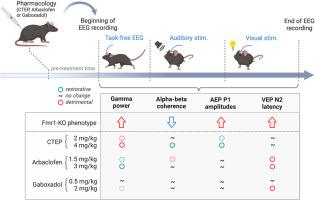临床探究的脆性 X 综合征作用机制未能使 Fmr1 基因敲除小鼠的翻译脑电图表型正常化。
IF 4.6
2区 医学
Q1 NEUROSCIENCES
引用次数: 0
摘要
脆性 X 综合征(FXS)是一种由脆性 X 信使核糖核蛋白(FMRP)缺乏引起的神经发育障碍。脆性 X 综合征的脑电图(EEG)变化包括振荡活动和对感觉刺激反应的改变,其中一些已通过敲除脆性 X 信使核糖核蛋白 1 基因(Fmr1-KO)反向转化为啮齿动物模型。然而,这些脑电图表型作为客观生物标志物的有效性还需要进一步研究。尽管在 Fmr1-KO 模型中挽救了许多表型,但这些治疗方法尚未转化为临床成功。然而,这些治疗方法都没有对 Fmr1-KO 模型的脑电图表型进行评估。因此,我们开始利用 "无任务"、听觉诱发电位(AEPs)和视觉诱发电位(VEP)范式发现 Fmr1-KO 小鼠的新脑电图表型,并利用受试者内设计探究 CTEP、阿巴洛芬和加博沙多对它们的调节作用。首先,我们报告了与 Fmr1-KO 相关的脑电图异常,这些异常与在 FXS 中观察到的异常非常相似,包括γ 波段功率升高、α/β 波段一致性降低、AEPs 增加和 VEPs 延迟。其次,我们发现药物治疗充其量只能使脑电图表型部分正常化。CTEP 恢复了阿尔法/贝塔波段相干性和 AEP 振幅,但未能使伽马功率和 VEP 延迟恢复正常。相反,阿巴洛芬降低了伽玛功率,但没有恢复一致性或 AEP 振幅,并进一步延迟了 VEP。加博沙多没有使任何脑电图表型恢复正常。我们的结论是,这些化合物使这些脑电图表型恢复正常的能力有限。本文章由计算机程序翻译,如有差异,请以英文原文为准。

Clinically-probed mechanisms of action in Fragile-X syndrome fail to normalize translational EEG phenotypes in Fmr1 knockout mice
Fragile X syndrome (FXS) is a neurodevelopmental disorder caused by Fragile X Messenger Ribonucleoprotein (FMRP) deficiency. Electroencephalogram (EEG) changes in FXS include alterations of oscillatory activity and responses to sensory stimuli, some of which have been back-translated into rodent models by knocking-out the Fragile X messenger ribonucleoprotein 1 gene (Fmr1-KO). However, the validity of these EEG phenotypes as objective biomarkers requires further investigation.
Potential pharmacotherapies such as mGluR5 inhibitors (e.g. CTEP; 2-chloro-4-((2,5-dimethyl-1-(4-(trifluoromethoxy)phenyl)-1H-imidazole-4-yl)ethynyl)pyridine), GABABR agonists (e.g. arbaclofen) and δ-containing GABAAR agonists (e.g. gaboxadol) have not translated into clinical success despite rescuing many phenotypes in the Fmr1-KO model. Yet none of these treatments have been assessed on EEG phenotypes in the Fmr1-KO model. Therefore, we set out to discover new EEG phenotypes in Fmr1-KO mice, using “task-free” and auditory-evoked (AEPs) and visually-evoked potential (VEP) paradigms, and probe their modulation by CTEP, arbaclofen and gaboxadol, using within-subjects designs.
First, we report Fmr1-KO-associated EEG abnormalities that closely resemble those observed in FXS, including elevated gamma-band power, reduced alpha/beta-band coherence, increased AEPs and delayed VEPs. Secondly, we found that pharmacological treatment, at best, only partially normalized EEG phenotypes. CTEP restored alpha/beta-band coherence and AEP amplitudes but failed to normalize gamma power and VEP latencies. Conversely, arbaclofen reduced gamma power but did not restore coherence or AEP amplitudes and further delayed VEPs. Gaboxadol did not normalize any EEG phenotypes.
We conclude that these compounds have limited ability to normalize these EEG phenotypes.
求助全文
通过发布文献求助,成功后即可免费获取论文全文。
去求助
来源期刊

Neuropharmacology
医学-神经科学
CiteScore
10.00
自引率
4.30%
发文量
288
审稿时长
45 days
期刊介绍:
Neuropharmacology publishes high quality, original research and review articles within the discipline of neuroscience, especially articles with a neuropharmacological component. However, papers within any area of neuroscience will be considered. The journal does not usually accept clinical research, although preclinical neuropharmacological studies in humans may be considered. The journal only considers submissions in which the chemical structures and compositions of experimental agents are readily available in the literature or disclosed by the authors in the submitted manuscript. Only in exceptional circumstances will natural products be considered, and then only if the preparation is well defined by scientific means. Neuropharmacology publishes articles of any length (original research and reviews).
 求助内容:
求助内容: 应助结果提醒方式:
应助结果提醒方式:


